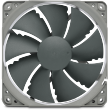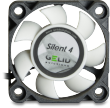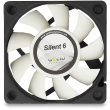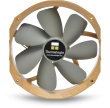TY-150 150mm PWM Fan Discontinued | |
| More variations available Show | |
Thermalright TY-150 150mm PWM Fan
The fan design of the TY-150, which is based on the TY-147, has been further improved. Due to its larger diameter it meets the desire of users to realise the greatest possible air flow rate at the lowest possible noise level.
Features
- Great airflow, low noise
- Double Ball Bearing for longevity
- Minimum noise only 22 dB(A)
- Maximum airflow 84.2 CFM
- 4-pin PWM connection
True to its motto “innovated - not imitated” Thermalright is constantly striving to develop new products or to further optimise already known models. Following this motto, the TY 150 is an innovative fan, which has been primarily developed as an upgrade for Thermalright cooler. The new fan provides a powerful alternative to the proven 140 mm fans of the TY-series.
The TY 150 has a speed range of 500-1,100 rpm and thus moves it even further in the low speed range (TY 147: 900-1300 rpm) - at the same time the maximum capacity is improved to nearly 84.2 CFM (TY 147: 73.6 CFM) while the maximum fan speed is reduced by some 200 rpm. The TY-150 provides an optimisation of the two key facts, due to its revised specifications: The fan on the one hand has a lower minimum speed and offers on the other hand at its maximum (now lower) speed a significantly higher air flow rate. Even at the minimum speed of 500 rpm the TY 150 provides a high flow rate of just under 38.2 CFM (TY 147: 56.6.CFM at 900 rpm).
Since the fan is primarily designed as an upgrade for existing Thermalright cooler, the TY 150 comes with a pair of matching fan brackets for the following Thermalright coolers: HR-02 Macho, Macho PCGH, Archon SB-E X2, True Spirit 140 BW and Silver Arrow SB-E.
The new design of the TY 150 produces a higher air flow rate than all other fans for CPU cooler currently on the market at identical speeds. This applies both for the minimum fan speed and the maximum speed. In conjunction with the optimised wings and streamlined framework a particularly effective and also very quiet air flow is realised.
The TY 150 is equipped with seven fan blades in the revised “torpedo” style. The bearing of the fan axis has been adjusted to the increased mechanical loading by the greater impeller - accordingly the TY 150 sports a double ball bearing.
The monitoring & control of the fan speed is done automatically by the motherboard (PWM), the fan thus provides a particularly sensitive and uniform speed adjustment.
Please note that the mounting points of the fan are not arranged in a square and the TY 150 thus is not universally applicable.
The dimension is 125 x 105 mm - the TY 150 is designed primarily as an upgrade option for current Thermalright coolers.
| Specifications | TY-150 150mm PWM |
|---|---|
| Dimensions | 170 x 153 mm |
| Installation Depth | 25.5 mm |
| Voltage Range | 6 - 13 V |
| Fan Speed | 500 - 1100 RPM |
| Air Flow | 38.2 - 84.2 CFM |
| Noise | 22 - 34 dB(A) |
| Durability | 50,000 h |
| Bearing | Double Ball Bearing |
| Connector | 4-Pin PWM |
| Warranty | 24 months |
| EAN barcode | 0814256000499 |
| Specifications | TY-150 150mm PWM |
|---|---|
| Dimensions | 170 x 153 mm |
| Installation Depth | 25.5 mm |
| Voltage Range | 6 - 13 V |
| Fan Speed | 500 - 1100 RPM |
| Air Flow | 38.2 - 84.2 CFM |
| Noise | 22 - 34 dB(A) |
| Durability | 50,000 h |
| Bearing | Double Ball Bearing |
| Connector | 4-Pin PWM |
| Warranty | 24 months |
| EAN barcode | 0814256000499 |
Product Resources
FAQ
How do I measure fan size?
The size of fan you need will generally be determined by the size of the fan fitting position in your PC case. The sizes of all the fans on our website are shown as measured along any one of the fan’s four sides, NOT the distance between the fan’s screw holes! Our most popular fan size is 120mm, followed by 80mm. This isn’t really dictated by customer preference, but more by recent designs of PC cases.
As for the thickness (depth) of the fan, generally 25mm (1 inch) is by far the most common depth, although smaller fans can have shallower depths such as 15mm or even 10mm. All our fans are 25mm thick unless otherwise stated. If you have any questions about which fan you should order, please don’t hesitate to get in touch.
If you know the distance between the fan mounting screw holes but don’t know what fan size to order, please see the following table. Note that the mounting hole measurements shown below are taken horizontally or vertically between the holes and not diagonally.
Screw hole spacings and fan sizes
Space Between Screw Holes Fan Size 32mm 40mm 40mm 50mm 50mm 60mm 60mm 70mm 72mm 80mm 83mm 92mm 105mm 120mm I received a small cable (resistor) with my fan; what is it for?
The resistor cable (also called Ultra Low Noise or ULN cable) is designed to allow the fan to run slightly slower for even quieter operation. The benefit in lower running noise is significant. Although the airflow will be reduced slightly, this usually has minimal effect on PC temperature. We would generally recommend using the ULN resistor cable for best results in almost all circumstances.
How can I tell which way the air blows through the fan?
Hold the fan so that the round fan sticker is facing you. You are looking at the rear of the fan. When you plug the fan in, the air will be blowing towards you. If you want a fan to act as an air intake, then the fan sticker will be facing the inside of the case. Some fans also have two small arrows moulded into their plastic housing - one arrow shows the direction of airflow, and the other (at 90°) shows the direction of blade rotation.
Is it possible to use a 4-pin PWM fan or CPU cooler with a motherboard which has only 3-pin fan headers on it?
Electrically, there is no problem doing this - the fourth pin on the fan cable is used purely for PWM control and is not needed in order for the fan to run. So you can plug the 4-pin fan connector onto the 3-pin motherboard fan header, leaving the fourth pin not connected to anything. The fan will potentially run at full speed, so if you would like to reduce the speed of the fan you will need to adjust the fan speed setting in your BIOS or use fan control software such as SpeedFan in Windows.
The only other problem to consider is that occasionally, components immediately adjacent to the motherboard fan header can get in the way of the larger 4-pin fan connector, physically preventing connection. This problem also occurs if you try to use an in-line fan speed controller such as the one made by Gelid.
Another avenue to explore is the possibility of using a bay-mounted fan controller. Several models are available now which provide 4-pin fan headers, so this is an easy way to use 4-pin PWM fans in a PC system which has only 3-pin fan headers on its motherboards. When using this method, you may find it necessary to disable any fan warning settings in your motherboard BIOS, since the motherboard may incorrectly believe that its CPU fan has failed when the fan is connected to a fan controller rather than directly to the motherboard itself.
Top Quiet Fans

Noctua NF-P12 REDUX PWM 12V 1700RPM 120mm Quiet Case Fan

Noctua NF-F12 iPPC PWM 12V 3000RPM 120mm High Performance Fan

Noctua NF-A12x25 PWM chromax.black.swap 12V 2000RPM 120mm Fan

Noctua NF-R8 REDUX 12V 1800RPM 80mm Quiet Case Fan

Noctua NF-A12x15 PWM chromax.black.swap 12V 1850RPM 120x15mm Fan

Noctua NF-A12x25 PWM 12V 2000RPM 120mm Ultimate Quality Quiet Fan

Gelid Silent 4, 40mm Quiet Case Fan

Noctua NF-R8 REDUX PWM 12V 1800RPM 80mm Quiet Case Fan

Gelid Silent 6, 60mm Quiet Case Fan

Noctua NF-A14 PWM chromax.black.swap 12V 1500RPM 140mm Fan


